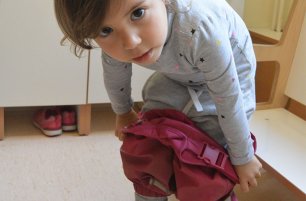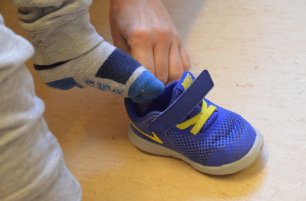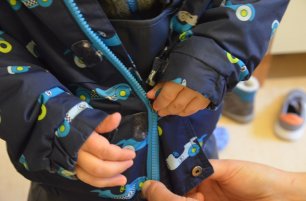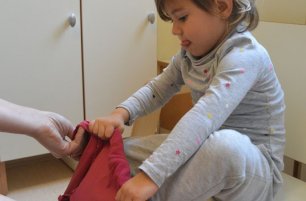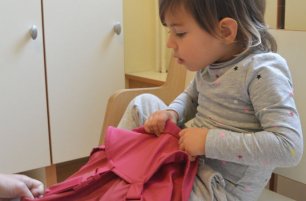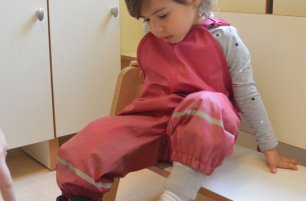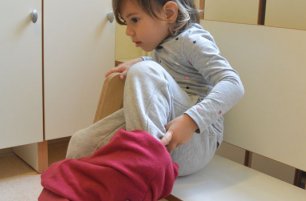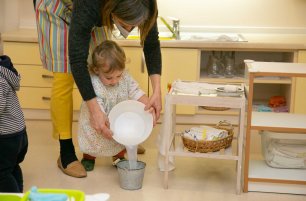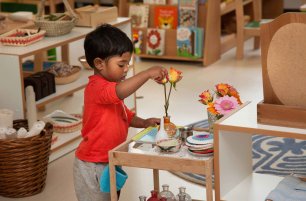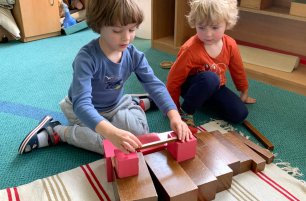How to Help your Toddler Get Dressed
Patience and a positive attitude are key when helping children with dressing and undressing. This means staying engaged with your child, maintaining eye contact, but also being patient as they process the information and movements.
When Using the Toilet
If your child needs help pushing their pants down, show them how to hold the waistband and push. Remember that the back of the pants can be a tricky area for toddlers as they have trouble reaching around their back and bottom. You can show them how to take their diaper off by themselves (or push a pull-up down) and sit on the potty or toilet.
When Changing Clothes
Start with shirts by pulling from the end of their sleeve and showing your child how to move their arm down from inside the shirt. At this point some children can do the rest by themselves others need more assistance. Continue with the second sleeve and showing your child how to push the shirt up and over their head.

Most children need help finding the neck hole and pulling it over their head. Younger children might need more assistance with finding the sleeves and pulling the shirt down in the back.
**Remember to give options! Show your child two shirts and ask which one they would like to wear. This helps your toddler feel more in control of their body and choices.
After your child has pushed their pants down, the tricky part is around the ankle cuffs. You can help by pulling the bottom of the pants off and your child can then take their legs out of the pants.
**After taking off their dirty clothing, it is a great practical life opportunity for your child to take their clothes to the laundry basket or washing machine!
When putting new pants on, you can hold your child’s hands and show them how to hold onto the waistbanand then ask him or her to put their legs, inside one at a time. You can help guide their feet through to the bottom and then ask your child to stand up and pull the pants up.
Winter is Coming – Tips for Going Outside!
Try giving gentle reminders. Ask questions like “What do you need?” “Where is your jacket?”
Boots and Shoes
It’s best for your child to sit down for this. If he or she seems to be struggling or getting frustrated, try just holding the shoe in place on the floor so it doesn’t move away. Your toddler can then put their foot inside and close the straps. It’s better to teach them how to push their foot into the shoe against the floor rather than against your hand.
Overalls (Rain and Snow Pants)
Remember to start from a sitting position - consistency is key! You can show them again where to hold onto their pants and then remind your child to put their legs inside. Once their pants are pulled up, you can show him or her where the straps are and they can put their arms inside.
Sweaters and Jackets
The jacket flip is such a time saver in the colder seasons! Start with laying the jacket open with its top by the child’s feet (so it looks upside down). Then you can show him or her how to put their arms inside the sleeves and lift their arms up and over. Once the jacket or sweater is on, your child may need help with attaching the but then let them pull the zipper up.
When undressing, you can ask them to pull the zipper down to start. They might need you to help by holding onto the sleeve cuff to start getting their arm out of the jacket. Then your child can practice taking the rest of their jacket off by themselves.
Remember that practice will eventually lead to independence! It’s best to keep these routines as consistent as possible and the more opportunities your toddler gets with dressing and undressing, the more comfortable and confident they will become. Soon you won’t need to help at all.
By Lindsey Taylor, Toddler Teacher Assistant
Want to learn more? Read our next article:
